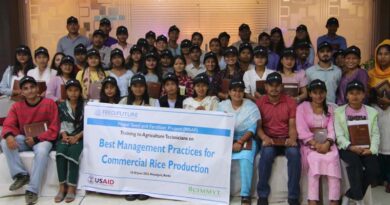Government of Nepal adopts new fertilizer recommendations
25 July 2023, Nepal: Balancing the application of fertilizers based on the characteristics of soil leads to increased crop productivity, income, and fertilizer use efficiency unlike former “one size fits all” recommendations, said Bedu Ram Bhushal, Nepal’s Minister of Agriculture and Livestock Development (MoALD) during a press briefing earlier this month in Nepal’s capital Kathmandu.
The site-specific recommendations applicable to maize, wheat, and rice were jointly launched with the Nepal Agricultural Research Council (NARC) and National Soil Science Research Center (NSSRC). They were implemented in collaboration with the Department of Agriculture (DoA) and led by the Nepal Seed and Fertilizer (NSAF) Project at the International Maize and Wheat Improvement Center (CIMMYT).
“I congratulate NARC for this historical work on updating the fertilizer recommendations after 46 years,” Bhushal said. “Now, we should support the large-scale adoption of these new recommendations by farmers for sustainable soil fertility management.”
Earlier recommendations developed by the Agricultural Chemistry and Soil Science Service Section under the Department of Agriculture (DoA) in 1976 did not take into account soil diversity, biophysical conditions, and agronomic management. Nutrients recommended for a particular crop were the same for terai lowlands, hills, and mountains.
In general, soil fertility changes over time due to deployment of continuous intensive cropping systems. The new recommendations consider the indigenous nutrient supply of soils, target yields, and the amount of nutrients removed by crops at harvest.
It took six years for NSSRC of NARC in partnership with NSAF, to update the recommendations through nutrient omission and optimum nutrient rate trials in various locations. By using advanced analytical methods and machine learning tools for extrapolating data across different agroecological zones and domains, they were able to make them site-specific.
Other factors considered, included attainable yield at a particular farm, soil fertility status, agro-climate, crop management practices, and the amount of nutrients to be supplied to fill the gap between crop nutrient removal and soil nutrient supply of nitrogen, phosphorus, and potassium. Micronutrients and organic inputs were also considered.
These recommendations were presented to leading soil scientists and agronomists from NARC and MoALD and were validated at national meetings in July and October 2022.
The new recommendations were included in the DoA’s agriculture extension guidelines in 2023, to achieve potential yield at the farm level and to link with the extension system through the three-tier of governments for its extensive use throughout the country. The new approach is part of CIMMYT’s efforts to support the NARC, MoALD, provincial agriculture ministries, and farmers to build indigenous soil fertility management resources and capabilities and promote locally adapted strategies for long-term resilience by using integrated soil fertility management approaches.
(For Latest Agriculture News & Updates, follow Krishak Jagat on Google News)















